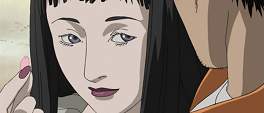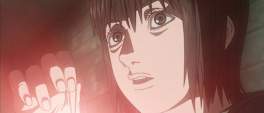First released: July 2004
Just like the taijitu that features so heavily in the plot, Otogi Zoshi is split into two parts with elements of its twin interspersed throughout. The tonal and aesthetic difference between the two parts is arresting, the first favouring a poised and atmospheric wander through a viciously feudal Japan, the latter a collection of modern mysteries scattered around Tokyo and sharing many similarities with the latest two Shin Megami Tensei: Persona video games. This division of themes and story promotes perseverance: if the initial tale of blades and intrigue doesn't engage, perhaps the dark and foreboding march across many of Tokyo's landmarks will. Conversely it threatens to alienate an audience that fell in love with the first story or losing them before the second begins. By and large it succeeds in crafting a compelling story with characters that, crucially, work across the gulf of a thousand years, however even with the guiding hand of Production I.G the series isn't without its flaws.
The Heian era city of Edo is infected by discontent: famine and lawlessness plague the streets while the outlying lands are run by thieves and malcontents. Even the Emperor isn't immune: struck down by a debilitating illness and without long to live, his closest aides, advised by the mystic Abe no Seimei, send word to retrieve the magical magatama stones in order to save the capital. With the eldest son of the Minamoto household, Raiko, bedridden it is up to his sister Hikaru to undertake this task. Disguised as her brother and joined by her faithful bodyguard Tsuna, and eventually the womanising Usui, the enigmatic Urabe and freakishly strong Kintaro, the group hunts out the magatama against foes both weird and devious. On their return however, all is not as it seems and the Emperor's aides have ulterior plans for the magatama, although it will be Seimei whose actions will have the most far reaching consequences, the ramifications echoing a thousand years into the future.
Whereas the second story is the stronger, it is the first which is the better realised. The Heian story doesn't have the measured atmosphere of other series in a similar setting such as Mushishi or the recent Saraiya Goyou but it has a robust structure thanks to the quests which compose the bulk of the story. The Tokyo story on the other hand hits the ground running with a divisive opening scene of Hikaru and Tsuna running from a garishly dressed speed gang, but then remains largely stagnant until the climax. Its reliance on the investigation of strange events occurring at famous landmarks around the city is its undoing, feeling more like a tourist trail than Hikaru's heartfelt mission to find her missing brother. Part of second story's weakness can also be attributed to the omission of details that would otherwise flesh it out: how Hikaru's old group came to live together, what Tsuna's actual job is, how Hikaru is doing at school - elements like these are incidental but would help better put the drastic shift from feudal to urban in context. As it is, one is never exposed to enough personality in the modern day Hikaru and her entourage to truly empathise with their plight.
At first, the many elements which are left unexplained promise to reinforce the overarching story's mystery, but it becomes obvious as the series evolves that they are simply underdeveloped - vestigial plot hooks that never blossomed. Aspects such as Hikaru's refusal to kill anyone despite her obvious archery prowess is brought to the fore in the opening episode, then ignored until the finale; similarly Hikaru's dual existence as Raiko is never exposed to her friends making their coalescing in the second story slightly dubious. Other points such as why the modern day Kintaro is being bullied, or why the ancient and powerful magatama are in the hands of ne'er-do-wells coupled with their foreboding talk of how they came into ownership of them is forgotten about just as the rather loosely implied connection between them is. The end result isn't enough to bring down an otherwise solidly constructed tale, but builds up an image of a chaotic screenplay that wasn't reigned in enough for the first half, but too much for the second.
The true measure of the series however is in how short each episode feels, even in the moments that manoeuvre characters in preparation for the next reveal, the slow and lilting endings seem to come all too quickly. It is the mark of expert pacing that this can be achieved, in a twenty six episode run there is not a single episode that pads out the run time, only the OVA of Urabe feels slightly superfluous but gifts her some critical screentime that she was missing in the second story. Similarly each story's climax which straddle multiple episodes are given breathing room to satisfy the plot and characters that had been carefully built up. The cast, although not as timeless as the story desires, are superbly crafted and the transposition from ancient to modern roles is surprisingly believable. Hikaru, while an excellent protagonist, suffers in the second story by erring more on the side of hysteria and whining than her more proactive past life; Kintaro meanwhile shifts from a precocious but enjoyable child to a useless and annoyingly grating brat. Regardless, the interplay between each member of the core group keeps it feeling coherent without over-egging aspects such as Tsuna's adoration of Hikaru or Usui and Urabe's burgeoning attraction.
Despite being in the afterglow of the unquestionably brilliant Ghost in the Shell: Standalone Complex, here Production I.G only manages a passable production. Over-stretching the budget with delicate and precise character designs, in practice they often look distorted angular. Fast motion scenes are as smooth as they should be however they come so infrequently and are over so quickly that it can difficult to tell exactly what transpired and only the aftermath indicates as much. To its credit the locations and dress of the characters changes so much that it is perhaps no surprise that so many shortcuts are taken: Hikaru rarely appears in the same garb twice in the modern story, switching between schoolgirl prep and urban pop with pleasing regularity. Musical duties are handed over to Hideki Tanuchi for the Heian arc and Kenji Kawai for the Tokyo Arc. The former demonstrates why he helmed the majority of Aoi Bungaku's score with some fitting and hugely atmospheric work; the latter on the other hand is equally evocative, but not as attuned to the situation as it should be: supremely confident but slightly out of place.
In aggregate then, Otogi Zoshi amounts to a sterling original series which connects two otherwise disparate stories with satisfying characters, a steady pace and little filler. Tightening in some places would have elevated the series from enjoyable to impressive and transferring the spirit of the first story into the second would go a long way to alleviating some gripes. On the one hand the series is slightly disappointing for not exploiting its past/present juxtaposition, the possibility to compare the cut-throat world of Heian era Japan to modern urban existence is tantalising, even making more use of the taijitu iconography wouldn't have gone amiss, although in the wake of Kara no Kyoukai:
Spiral Paradox even that would have perhaps fallen flat. In spite of this, the series is a worthwhile investment and covers enough material to be appealing to most audiences however muted the end result is.











